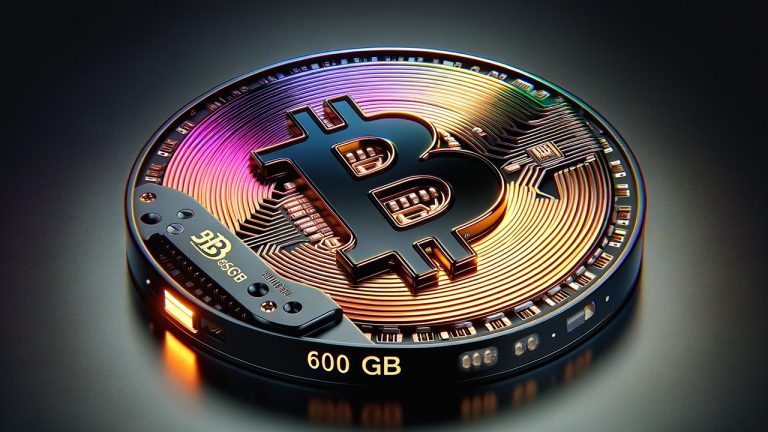
Although bitcoin’s price hasn’t eclipsed its historic peak, this year the network has shattered multiple records. These include reaching the highest level of difficulty, achieving an all-time high in total hashrate, and setting a new record for daily confirmed transactions. In 2023, another new milestone was achieved as the distributed ledger expanded to half a terabyte, surpassing 500 gigabytes in size to accommodate the entire blockchain’s records.
Bitcoin Exceeds 500 GB Blockchain Size Amidst Unprecedented Transactional Growth
To maintain an unpruned Bitcoin blockchain, node operators now need in excess of 500 gigabytes (GB) of available storage. Downloading the full blockchain would take about 47 hours and 44 minutes using a standard 24 Mbps ADSL connection.
Conversely, with a 100 Mbps fiber optic connection, the process shortens to roughly 11 hours and 22 minutes, assuming there’s no network congestion or server restrictions. Current data reveals that the Bitcoin blockchain’s size has reached 534.49 GB, exceeding half a terabyte (TB).
Around 431 days ago, or one year and two months back on October 15, 2022, the blockchain was approximately 432 GB. This indicates a growth of just over 100 GB in the past year, a rate faster than usual.
This acceleration is primarily due to the average Bitcoin block size increasing significantly in 2023, with this trend notably beginning on January 2, 2023. The rise of Bitcoin block sizes stems from the Ordinals inscription trend that started in December 2022.
By the first week of January, the average block size increased and by Feb. 12, 2023, it ramped up to 2.517 megabytes (MB). A great example is the mean average block size for Bitcoin between Jan. 1, 2020, and Nov. 30, 2022, (1,064 days) was approximately 1.2 MB.
But the mean average block size for Bitcoin from Jan. 3, 2023, to Dec. 19, 2023, (350 days) was approximately 1.705 MB. Across the entire 365 days in 2016, the mean average block size for Bitcoin was .781 MB, and in 2017 across the entire year, the mean average was .949 MB.
Besides 2018, the following years thereafter the average block size and the mean average across 365-day intervals has always been above 1 MB. The mean average for 2022 was 1.19 MB and so far, while 2023 is close to done, the mean average is now 1.70 MB.
While it is a considerable increase from yesteryears, 1.7 MB is still not enough for current block space demand. Presently, there are 306,379 transactions stuck in the mempool (a backlog of unconfirmed transfers) and miners need to clear 349 blocks just to get ahead.
A high-priority fee onchain on Dec. 20, 2023, is $15.32 per transaction. With Ordinal inscriptions and traditional monetary transfers, BTC is seeing upwards of 600,000 transactions per day or an average of 7.93 transactions confirmed per second.
The growth and evolution of the Bitcoin network in 2023 underscore the dynamic nature of the crypto landscape. While the size of the blockchain is increasing, surpassing the half-terabyte mark, Bitcoin continues to display remarkable resilience and adaptability.
The significant increase in average block size, primarily driven by the Ordinals inscription trend, reflects the ever-changing demands and innovations within the network. However, this growth has also highlighted the limitations of the current infrastructure, as evidenced by the considerable number of transactions stuck in the mempool and the need for higher transaction fees to expedite processing.
What do you think about the Bitcoin blockchain crossing beyond 500 GB? Share your thoughts and opinions about this subject in the comments section below.














